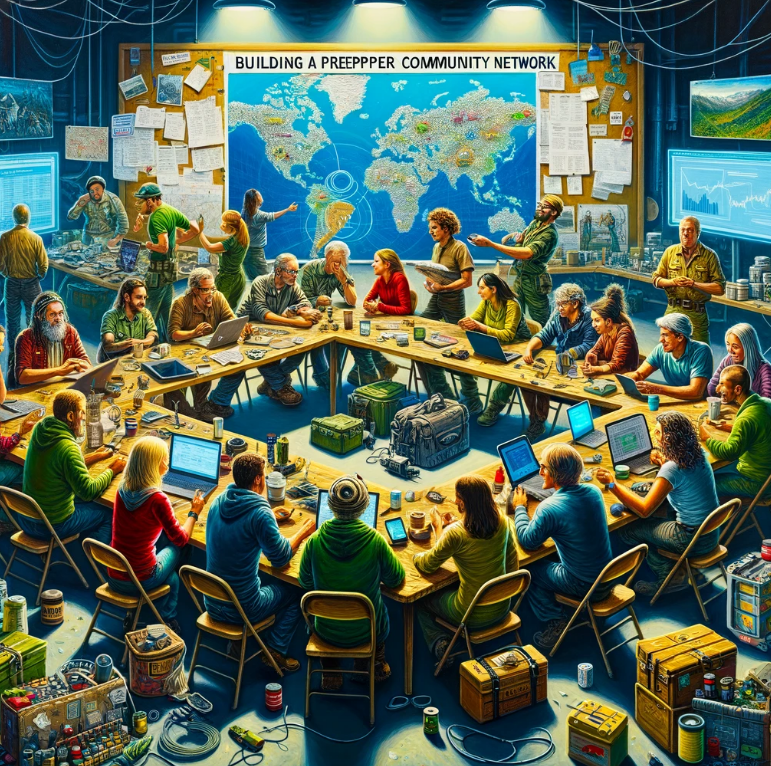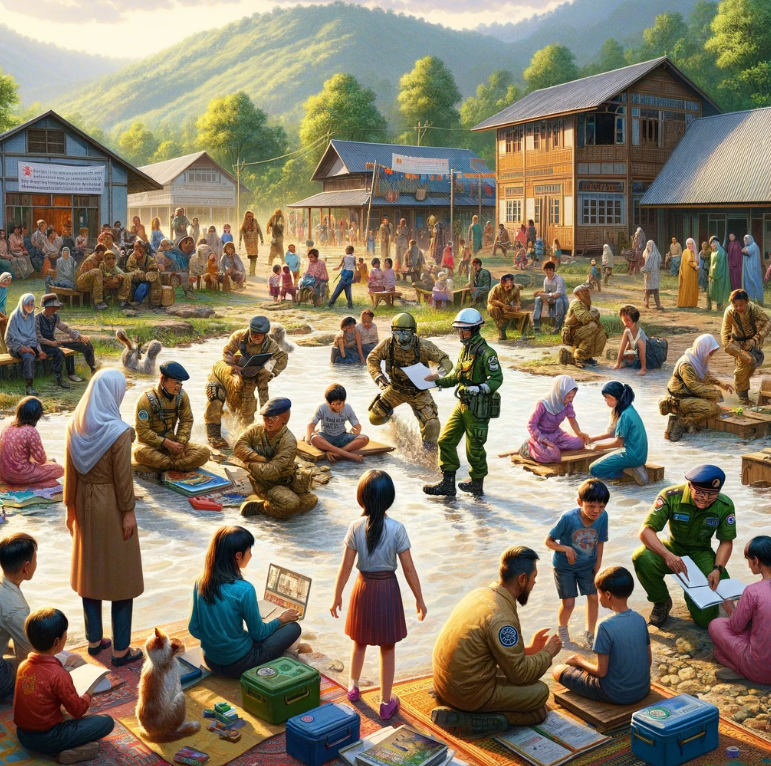Table of Contents
- 1 Introduction to Building and Nurturing Survival Communities
- 2 Foundations of Survival Communities
- 3 Building a Prepper Community Network
- 4 Nurturing and Sustaining Survival Groups
- 5 Essential Tools and Resources for Effective Prepping
- 6 Overcoming Common Challenges
- 7 Enhancing Community Engagement and Learning
- 8 Final Remarks
- 9 Frequently Asked Questions
Views: 2
Introduction to Building and Nurturing Survival Communities
Highlighting the significance of survival communities in enhancing preparedness and resilience
Building and nurturing survival communities can play a crucial role in enhancing emergency preparedness levels by pooling together resources, knowledge, and skills. In times of uncertainty or crisis, these communities provide a safety net for individuals. Collective efforts within these networks amplify the strength and resilience to withstand challenges and protective factors that may arise.

Mutual support is at the core of survival communities, where members come together to assist one another during difficult times, building trust and networks. This shared sense of camaraderie fosters a strong bond among group members, creating networks of trust and reliability. Shared resources, such as food, medical supplies, or shelter provisions, ensure that no member is left behind in times of need.
Brief explanation of community prepping and its advantages
Community prepping involves survival groups pooling together resources like food supplies, tools and gear, and expertise to better prepare for unforeseen events. By combining individuals’ assets into a collective pool, success rates of networks are significantly improved when facing challenges. Diverse skill sets within a community and networks ensure that various tasks can be handled efficiently without solely relying on one person’s capabilities.
The advantages of diverse skill sets within a prepper community are vast. Members bring different expertise ranging from medical knowledge to carpentry skills or farming experience. This diversity ensures that there is always someone equipped to handle various aspects essential for survival in challenging situations. Pooling resources among individuals, survival groups, and networks also means that costs can be shared among members leading to more cost-effective preparations for life.
Foundations of Survival Communities
Defining a survival community and its key components

Survival communities are networks of individuals who come together to support each other in times of crisis. Trust forms the cornerstone of these survival groups, fostering strong bonds among members. Cooperation is vital for sharing resources and skills efficiently.
Establishing shared values ensures that everyone aligns on principles guiding the community’s actions. Having a common goal, such as long-term sustainability or self-sufficiency, unites members towards a collective purpose in survival groups.
The fundamental values and principles guiding successful communities
Integrity lies at the core of successful survival communities, emphasizing honesty and ethical behavior in life and groups. Inclusivity ensures that all voices are heard and valued within the group, promoting diversity and equality.
Maintaining transparency builds trust among members, fostering an environment of openness and accountability. Embracing adaptability, especially in changing circumstances or challenges, enables prepper communities, and survival groups, to evolve and thrive over time.
Open communication channels play a crucial role in disseminating information effectively throughout the community. This allows for quick decision-making processes based on consensus-building rather than individual agendas.
Building a Prepper Community Network
Identifying and connecting with like-minded individuals
To network effectively and connect with like-minded individuals sharing similar survivalist values, join local prepper groups or online forums. Engage in discussions, share experiences, and exchange knowledge on preparedness strategies in survival groups. Expand your connections by attending relevant workshops or seminars to meet new like-minded individuals.

Connecting with a diverse range of people outside your immediate circles brings fresh perspectives and skills to the community network. It enhances the collective knowledge base, fostering innovation in survival techniques in a group. Collaborating with a broader network also increases access to varied resources and expertise during crises.
Start by setting clear and achievable objectives for the group, focusing on common survival goals such as long-term food storage and rotation or emergency response drills. Assign responsibilities based on individual strengths within the community network to ensure efficient progress towards these goals. Regularly review and adjust objectives as needed to adapt to changing circumstances.
Organize engaging events like skill-sharing workshops, group training sessions, or social gatherings to strengthen bonds within the prepper community network and survival groups. These activities not only build camaraderie but also enhance trust among members, essential for effective collaboration during emergencies. Encourage active participation from all members to foster a sense of belonging and unity.
Establishing effective communication channels for ongoing collaboration
Utilize various tools such as social media platforms, messaging apps like Signal or Telegram, and email newsletters to facilitate seamless communication within the prepper community network. Cryptographic signatures via things such PGP can be useful in verification of user identities over distances. Create dedicated groups or channels for specific topics such as first aid training or disaster preparedness updates to streamline information sharing. Ensure all members are familiar with these communication channels for quick dissemination of critical information during emergencies.
Clear communication protocols are crucial for ensuring timely responses and coordinated actions during crisis situations within the community network. Establish guidelines for reporting emergencies, sharing updates on resource availability, and coordinating relief efforts effectively. Regularly practice emergency communication drills to test the efficiency of these protocols and address any potential gaps proactively.
Nurturing and Sustaining Survival Groups
Implementing communication strategies to maintain unity

Effective communication is vital for the cohesion of survival groups. Active listening fosters understanding among group members, ensuring everyone feels heard and valued. Providing constructive feedback helps in addressing issues promptly and constructively.
To navigate the complexities of group dynamics, implementing tailored conflict resolution techniques is crucial. Encouraging open dialogue and mutual respect can resolve conflicts efficiently, strengthening relationships within the group.
Organizing skill-sharing and educational workshops
Organizing regular skill-sharing workshops enhances the collective knowledge base of the group. Offering training sessions on topics like first aid, food preservation, or self-defense equips members with essential skills for survival situations.
Continuous learning through educational workshops not only benefits individual growth but also contributes to the overall resilience of the group. Sharing expertise fosters a sense of community and ensures that every member plays a valuable role in sustaining the group.
Developing a system for sharing resources and support within the group
Creating a structured system for resource sharing promotes collaboration and solidarity among members. Maintaining detailed resource inventories helps in efficient allocation during emergencies while designated roles for resource management ensure accountability within the group.
Establishing mutual aid agreements among members strengthens interdependence and support networks within survival groups. By pooling resources and skills, members can effectively address challenges together, reinforcing their collective resilience against various threats.
Essential Tools and Resources for Effective Prepping
Recommendations for individual and community equipment

When preparing for emergencies, having essential tools is crucial. Water filters such as a LifeStraw are vital to ensure a clean water supply. Emergency food supplies like MRE(Meals Ready to Eat) and other non-perishable items can sustain individuals during crises. Communication devices such as radios or walkie–talkies are essential for staying connected in times of need.
Strategies like bulk purchasing help save costs by buying in large quantities together. Sharing equipment within the community fosters cooperation and preparedness.
Overview of critical tools and supplies for a well-prepared community
Generators are indispensable during power outages, providing electricity for essential appliances. Emergency preparedness kits and or a Bug-out Bag stocked with first-aid supplies such as bandages, medications, and other useful medical items are necessary for treating injuries promptly.
DIY Shelter materials like tents or tarps offer protection from the elements in temporary living situations. Navigation tools such as maps and compasses aid in finding directions when GPS systems fail. Redundancy in critical supplies ensures that there are backup options available if primary resources run out.
Overcoming Common Challenges
Addressing typical obstacles faced by survival communities
Survival communities often encounter challenging situations that test their resilience. Internal conflicts arising from differing opinions and priorities can hinder progress. To overcome these hurdles, fostering open dialogue and promoting consensus-building are crucial. By encouraging transparent communication, members can address issues collectively.

When facing external threats such as natural disasters or economic instability, survival communities must be prepared to respond effectively. Developing contingency plans and establishing emergency protocols can help mitigate potential risks. By prioritizing disaster readiness and implementing proactive measures, communities can enhance their strength in the face of adversity.
Practical advice and strategies for resolving common issues
To navigate internal challenges within a survival community, implementing conflict resolution frameworks is essential. These frameworks should be tailored to accommodate diverse opinions and group dynamics effectively. Encouraging respectful discussions and finding common ground are key aspects of successful conflict resolution.
When making critical decisions that impact the entire community, it is vital to prioritize collective well-being over individual interests. Establishing clear decision-making processes that involve input from all members fosters a sense of inclusivity and unity. By considering various perspectives and weighing different considerations, communities can make informed choices that benefit everyone.
Enhancing Community Engagement and Learning
Ideas for community-building activities and events

Engage community participation through diverse activities like outdoor excursions, skills competitions, or potluck gatherings. These events foster connections among members by creating shared memories. Consider organizing emergency drills to enhance preparedness and teamwork within the group.
These simulations not only improve response times but also strengthen trust and collaboration.
Encourage participation in skill-sharing workshops where individuals can teach each other valuable survival skills and techniques. This promotes a culture of continuous learning and mutual support within the community.
To deepen bonds, plan social gatherings that celebrate cultural diversity or traditional festivities. These occasions provide opportunities for members to appreciate each other’s backgrounds and strengthen unity.
Opportunities for continuous learning and improvement
Regularly assess the effectiveness of group dynamics to identify areas for improvement. Conduct feedback sessions to address conflicts constructively and enhance communication channels.
Track individual progress in acquiring new skills or knowledge related to survival techniques. Recognize achievements publicly to motivate others and create a culture of excellence within the community.
Review emergency response plans periodically to ensure they remain relevant and effective. Incorporate feedback from practice drills or real-life situations into updated strategies for better outcomes.
Adapt participation strategies based on lessons learned from past experiences, whether positive or challenging. Embrace change as an opportunity for growth and innovation within the survival community.
Final Remarks

In navigating the intricate landscape of building and nurturing survival communities, you’ve uncovered the vital pillars that uphold these groups. By embracing collaboration, preparation, and resilience, you’re not just fortifying your community but also fostering a network of support that can weather any storm. Remember, your commitment to learning, adapting, and engaging with others is the cornerstone of a thriving survival community.
As you embark on this journey towards building a robust and sustainable survival network, continue to seek knowledge, share experiences, and empower those around you. Your dedication to preparedness not only safeguards your future but also paves the way for a resilient and interconnected community. Together, you can overcome challenges, celebrate victories, and create a legacy of strength and unity.
Frequently Asked Questions
Can anyone join a survival community?
Yes, most survival communities welcome individuals who share their values and commitment to preparedness. It’s essential to align with the group’s goals and contribute positively to the community.
How can I find or start a prepper community network?
You can search online platforms, attend local preparedness events, or join social media groups focused on prepping. Starting your own network involves reaching out to like-minded individuals in your area.
What are some common challenges faced by survival communities?
Survival communities often encounter issues such as communication breakdowns, lack of resources, conflicts over leadership or decision-making, and maintaining member engagement over time.
How do successful survival communities sustain themselves long-term?
Successful communities prioritize ongoing training, skill-sharing, mutual support among members, regular drills and exercises for readiness, fostering a sense of belonging and purpose among members.
Why is community engagement crucial for effective prepping?
Community engagement fosters collaboration, resource-sharing, knowledge exchange among members. It enhances overall resilience by pooling diverse skills and experiences towards collective preparedness efforts.




Your article helped me a lot, is there any more related content? Thanks!
Check out https://bobbiesbunker.com/category/blog/ 😛 It has a more in depth list of the contents on our site thus far!
Pingback: DeFi and Doomsday Preparation: Synergy & Strategies
Pingback: #1 Best Guide to Financial Prepping with Crypto
Pingback: Yield Farming for Doomsday Preppers: 10 Essential Tips